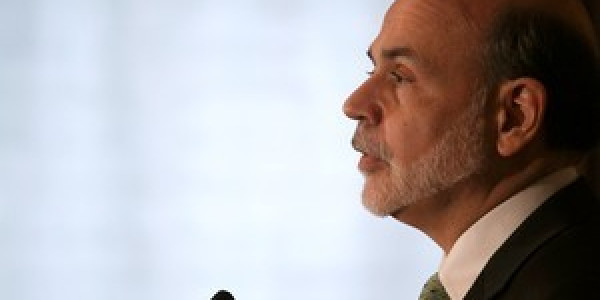Kenneth Rapoza , Contributor INVESTING | 8/20/2013 Emerging Markets Have Farther To Fall Emerging market investors worried about this guy: Ben Bernanke and the Federal Reserve’s quantitative easing policy. The market will get a better sense of so-called “tapering” of QE in the FOMC meeting minutes due out on Wednesday. Barclays Capital expects more pain for emerging market equity and bonds, in the meantime. (Image credit: Getty Images via @daylife) The emerging markets have farther to fall and they can lay the blame on Ben Bernanke and the Federal Reserve for their sad-sack performance over the last several days. On Tuesday, the iShares MSCI Emerging Markets Index (EEM) was trading slightly lower following Monday’s 1.86% drop. Will investors buy on the lows? Of course they will. But is this a market ripe for deeper corrections? It sure is, says Barclays BCS +0.34% Capital analyst Koon Chow in London. Risky assets continue to be weighed down by rising rates in the U.S. Ten year Treasury bonds are now yielding 2.83%. In London trading hours this morning, European equities followed the downbeat tone in Asian markets. Meanwhile, high yielding currencies like the Brazilian real are bearing the brunt in the forex markets. And it’s not over yet. This underperformance is likely to continue as the starting point of Fed tapering nears, said Chow in his daily note to clients today. Right now, all eyes are on the Fed Open Market Committee Meeting (FOMC) minutes coming out on Wednesday. The risk associated with the FOMC minutes is whether the Fed has begun discussing a possible change in its threshold rate for unemployment as a means of continuing its QE program. Remember, Bernanke said that he would not step on the break of quantitative easing until unemployment levels were comfortably below 7%, or at the very least, trending downward. Unemployment has been trending downward, but at a slower pace. Any discussion of a move away from waiting for lower unemployment will likely to be viewed as a dovish surprise by the market and may lead to a near-term rally for global bonds. Equities would also bounce. The noticeable lack of a broad dollar rally, despite the sharp moves against high yield currencies, suggests that the market may already be positioning for such an announcement. One of the problems right now with emerging market investing is fund managers are allocating out of them faster than anyone expected. The positioning in emerging markets is still problematic, said Chow, although arguably slightly less negative in equities than in fixed income where global institutional and retail positions are still large. This would suggest that there can be some asymmetry in emerging markets in the months ahead, with greater risks of disruptive moves in fixed income than in equities. Fund managers do not want to be caught holding the same positions, with the same weighting post-QE as they were during QE. This is driving the bulk of the moves in the market these days. Meanwhile, the investment patterns in developed markets seems different. While in emerging, investors have had asset allocation shifts that look more like “risk reduction”, developed market positioning is suggestive of only the early stages of the great rotation out of fixed income to equities, Barclays’ Chow said. The stock of cumulative retail inflows (as opposed to institutional) to developed market equities since early 2009 is actually negative. But institutional investors have not seen such a radical exit from their emerging equity positions. Since the financial crisis, the cumulative position of retail investment into developed market equity mutual funds is still negative ($239 billion less), but it has been offset by large institutional flow into the market ($364 billion), according to Cambridge, Mass. based fund trackers EPFR Global. EFPR Global data also shows that investment outflow from emerging markets is suggestive of broader risk reduction. Investors in retail funds have nearly completed their exit from emerging. They have also reduced their bond holdings by about 25% from multi-year highs in May. The flows from institutional funds, by contrast, have been “stickier”, said Chow, and sold in moderate amounts of both equities and debt since late May. “Although the institutional investors’ decisions should be more long-term focused and therefore naturally less likely to exit, the fact that they have not reduced their positions significantly is an unhelpful positioning technical and they may need to see a further drop in prices to buy,” Chow said. He expects more volatility, and downside risks. Technically speaking, emerging equity looks better than bonds given the considerably more advanced overall exit by both retail and institutional at this point, Chow said. A look at the assets wealthy investors assumed would return the most for their portfolios this year. Taylor Scott International
Emerging Markets Have Farther To Fall

This entry was posted in Investment, investments, London, News, Property, Shows, Taylor Scott International, TSI, Uk and tagged asian, calendar, contributor, emerging, european, financial, green, investments, kenneth, london, markets. Bookmark the permalink.







